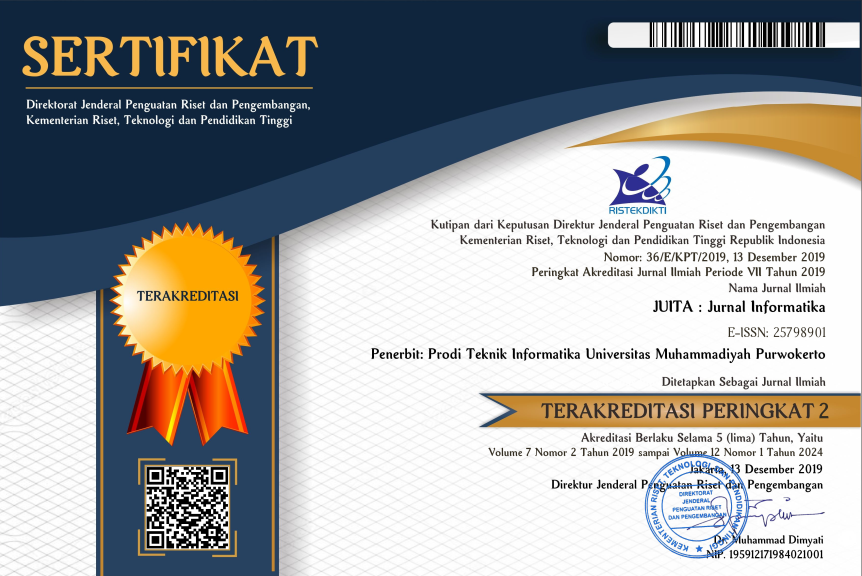Expert System of Dengue Disease Using Artificial Neural Network Classifier
DOI:
https://doi.org/10.30595/juita.v10i1.12476Keywords:
Dengue, Expert System, Classification, Backpropagation, Cross ValidationAbstract
Abstract – Expert systems can be applied to the classification of dengue fever. Dengue is a serious disease that can be fatal if not diagnosed and treated properly. Headache, muscle aches, fever, and rash are some of the most prevalent symptoms. Dengue fever is a disease that is endemic in various South Asian and Southeast Asian nations. Dengue fever (DF), dengue hemorrhagic fever (DHF), and dengue shock syndrome are the three types of dengue (DSS). Currently, these diseases may be classified using a machine learning approach with dengue symptoms as the input data. This study proposes implementing an Artificial Neural Network (ANN) with the Backpropagation (BPNN) algorithm as the classifier to categorize dengue types, divided into three categories: DF, DHF, and DSS. The dengue symptoms are represented by 21 attributes in the dataset. It was gathered from 110 patients. Cross-validation with k-fold 3, 5, and 10 were applied as the evaluation method. Three parameters were obtained to evaluate the ANN classification method: precision, recall, and accuracy. These were used to justify the most optimal performance. Cross-validation using k-fold 3 produced the best evaluation results, with precision, recall, and accuracy values of 97.3%, 97.3%, and 97.27%, respectively.References
[1] A. Saibene, M. Assale, and M. Giltri, “Expert systems: Definitions, advantages and issues in medical field applications,” Expert Syst. Appl., vol. 177, no. November 2020, p. 114900, 2021.
[2] S. Chatterjee, D. Dey, S. Munshi, and S. Gorai, “Dermatological expert system implementing the ABCD rule of dermoscopy for skin disease identification,” Expert Syst. Appl., vol. 167, no. November 2020, 2021.
[3] A. Salam, Sri Suryani Prasetiyowati, and Yuliant Sibaroni, “Prediction Vulnerability Level of Dengue Fever Using KNN and Random Forest,” J. RESTI (Rekayasa Sist. dan Teknol. Informasi), vol. 4, no. 3, pp. 531–536, 2020.
[4] B. Ajlan, M. Alafif, M. Alawi, N. Akbar, E. Aldigs, and T. Madani, “Assessment of the new World Health Organization’s dengue classification for predicting severity of illness and level of healthcare required,” bioRxiv, p. 516229, 2019.
[5] R. Gangula, L. Thirupathi, R. Parupati, K. Sreeveda, and S. Gattoju, “Ensemble machine learning based prediction of dengue disease with performance and accuracy elevation patterns,” Mater. Today Proc., no. xxxx, 2021.
[6] R. T. Sasmono, A. Sutjianto, M. S. Santoso, K. Sriwedari, B. Yohan, E. Mayasanti, R. F. Hayati, and D. Denis, “Molecular epidemiology of dengue in North Kalimantan, a province with the highest incidence rates in Indonesia in 2019,” Infect. Genet. Evol., vol. 95, no. May, p. 105036, 2021.
[7] H. Abid, M. Malik, F. Abid, M. R. Wahiddin, N. Mahmood, and I. Memon, “Global Health Action Nature of Complex Network of Dengue Epidemic As Scale-Free Network,” Healthc. Inform. Res., vol. 25, no. 3, pp. 182–192, 2018.
[8] I. Tougui, A. Jilbab, and J. El Mhamdi, “Impact of the Choice of Cross-Validation Techniques on the Results of Machine Learning-Based Diagnostic Applications,” Healthc. Inform. Res., vol. 27, no. 3, pp. 189–199, 2021.
[9] Z. Rustam, F. Zhafarina, G. S. Saragih, and S. Hartini, “Pancreatic cancer classification using logistic regression and random forest,” IAES Int. J. Artif. Intell., vol. 10, no. 2, pp. 476–481, 2021.
[10] N. A. Mashudi, N. Ahmad, and N. M. Noor, “Classification of adult autistic spectrum disorder using machine learning approach,” IAES Int. J. Artif. Intell., vol. 10, no. 3, pp. 743–751, 2021.
[11] A. Salam, Sri Suryani Prasetiyowati, and Yuliant Sibaroni, “Prediction Vulnerability Level of Dengue Fever Using KNN and Random Forest,” J. RESTI (Rekayasa Sist. dan Teknol. Informasi), vol. 4, no. 3, pp. 531–536, 2020.
[12] A. Septiarini, D. M. Khairina, A. H. Kridalaksana, and H. Hamdani, “Automatic glaucoma detection method applying a statistical approach to fundus images,” Healthc. Inform. Res., vol. 24, no. 1, pp. 53–60, 2018.
[13] J. J. Patel and S. K. Hadia, “An enhancement of mammogram images for breast cancer classification using artificial neural networks,” IAES Int. J. Artif. Intell., vol. 10, no. 2, pp. 332–345, 2021.
[14] M. S. Efendi and H. A. Wibawa, “Prediksi Penyakit Diabetes Menggunakan Algoritma ID3 dengan Pemilihan Atribut Terbaik ( Diabetes Prediction using ID3 Algorithm with Best Attribute Selection ),” Juita, vol. VI, no. 1, pp. 29–35, 2018.
[15] R. Ardiansyah, F. Fauziah, and A. Ningsih, “Sistem Pakar Diagnosa Awal Penyakit Lambung Menggunakan Metode Dempster-Shafer Berbasis WEB,” vol. 24, no. 3, pp. 182–196, 2018.
[16] Laurentinus, “Demster Shafer dengan Fuzzy Expert System Pada Deteksi Penyakit Stroke,” J. Resti, vol. 1, no. 10, pp. 837–845, 2021.
[17] Y. Yohannes, S. Devella, and K. Arianto, “Deteksi Penyakit Malaria Menggunakan Convolutional Neural Network Berbasis Saliency,” JUITA J. Inform., vol. 8, no. 1, p. 37–44, 2020.
[18] H. Mustafidah and S. Suwarsito, “Performance of Levenberg-Marquardt Algorithm in Backpropagation Network Based on the Number of Neurons in Hidden Layers and Learning Rate,” JUITA J. Inform., vol. 8, no. 1, p. 29–35, 2020.
[19] Y. A. Lesnussa, C. G. Mustamu, F. Kondo Lembang, and M. W. Talakua, “Application of Backpropagation Neural Networks in Predicting Rainfall Data in Ambon City,” Int. J. Artif. Intell. Res., vol. 2, no. 2, 2018.
[20] A. F. Daru, M. B. Hanif, and E. Widodo, “Improving Neural Network Performance with Feature Selection Using Pearson Correlation Method for Diabetes Disease Detection,” JUITA J. Inform., vol. 9, no. 1, p. 123–130, 2021.
[21] M. Sokolova, N. Japkowicz, and S. Szpakowicz, “Beyond accuracy, F-score and ROC: A family of discriminant measures for performance evaluation,” AAAI Work. - Tech. Rep., vol. WS-06-06, no. January, pp. 24–29, 2006.
[22] X. Deng, Q. Liu, Y. Deng, and S. Mahadevan, “An improved method to construct basic probability assignment based on the confusion matrix for classification problem,” Inf. Sci. (Ny)., vol. 340–341, pp. 250–261, 2016.
Downloads
Published
How to Cite
Issue
Section
License

JUITA: Jurnal Informatika is licensed under a Creative Commons Attribution 4.0 International License.
















